The landscape of education is on the brink of a revolution, driven by the integration of artificial intelligence (AI) into classrooms around the globe. As educators seek innovative ways to enhance learning experiences and operational efficiency, the potential of AI stands as both an exciting frontier and a complex challenge. While technologies such as intelligent tutoring systems, automated grading, and personalized learning algorithms promise to tailor education to the needs of each student, they also raise important questions about equity, data privacy, and the role of teachers in an AI-enhanced environment. In this article, we will explore the dual-edged sword of AI in education, examining the challenges that educators face in its implementation and the myriad opportunities it offers in fostering a more engaging, effective, and inclusive learning experience. By delving into these crucial aspects, we aim to equip educators, administrators, and stakeholders with the insights needed to navigate this transformative journey with confidence and foresight.
Table of Contents
- Understanding the Ethical Implications of AI in Education
- Enhancing Student Engagement Through AI-Driven Tools
- Training Educators for Effective AI Integration
- Fostering Collaboration Between AI Developers and Schools
- Final Thoughts
Understanding the Ethical Implications of AI in Education
In the digital age, integrating artificial intelligence into educational environments presents a multitude of ethical considerations that educators and institutions must navigate. One significant concern lies in data privacy. The collection and analysis of student data to tailor AI-driven learning experiences can lead to potential misuse or breaches of sensitive information. To mitigate these risks, institutions should implement stringent data protection policies and ensure transparency with students and parents regarding how their data is used. This fosters trust and upholds the moral responsibility of safeguarding learner information.
Moreover, the use of AI tools raises questions about equity in access. There is a risk that deploying sophisticated technologies may inadvertently deepen the digital divide, leaving underserved student populations without the necessary resources to benefit from AI-enhanced learning. It is essential to ensure that all students have equal access to these innovations, which can be achieved by investing in infrastructure and training for both educators and learners. Furthermore, fostering a culture of inclusivity in AI applications can help tailor educational experiences that consider diverse learning needs and styles.
Enhancing Student Engagement Through AI-Driven Tools
As educational institutions increasingly adopt AI technologies, the potential for enhancing student engagement becomes evident. AI-driven tools, such as personalized learning platforms and intelligent tutoring systems, allow educators to tailor their teaching methods to meet individual student needs. This customization not only promotes a deeper understanding of the subject matter but also encourages students to take an active role in their learning. Some of the notable benefits include:
- Adaptive Learning: Platforms that adjust content in real-time based on student performance.
- Gamification: Incorporating game-like elements to create a more engaging learning environment.
- Immediate Feedback: Providing students with instant evaluations on their work, fostering improvement.
Furthermore, the use of AI in classrooms can transform classrooms into dynamic environments where collaboration flourishes. Virtual Discussion Assistants and Collaborative Learning Tools powered by AI can facilitate meaningful interactions among students, fostering a sense of community. Metrics derived from these tools can also provide educators with insights into engagement trends. The following table illustrates some key features that can make AI tools effective for student interaction:
| Feature | Benefit |
|---|---|
| Real-Time Analytics | Insight into student progress and participation levels |
| Peer Feedback Mechanisms | Encourages collaborative learning and peer support |
| Interactive Content Creation | Stimulates creativity and active participation in learning |
Training Educators for Effective AI Integration
To harness the full potential of AI in educational settings, it is crucial to equip educators with the skills and knowledge necessary for effective integration. Professional development programs should focus on hands-on training that enables teachers to become familiar with various AI tools and applications. By creating a supportive environment for trial and exploration, educators can gain confidence in utilizing AI to personalize learning, enhance engagement, and streamline administrative tasks. Key components of such training programs include:
- Workshops on AI tool navigation.
- Peer collaboration for sharing best practices.
- Real-world case studies demonstrating successful integration.
- Ongoing support through mentorship and resources.
Furthermore, addressing common concerns and misconceptions about AI in the classroom is essential for fostering a positive environment. Professional development should include discussions on data privacy, ethical considerations, and the limitations of AI, ensuring that educators can approach these technologies with a critical mindset. To illustrate the potential impacts of AI on education, consider the following table highlighting key benefits that effective training can provide:
| Benefit | Description |
|---|---|
| Enhanced Personalization | AI can adapt learning experiences based on individual student needs. |
| Increased Efficiency | Automating administrative tasks allows teachers to focus on instruction. |
| Improved Engagement | Interactive AI tools can help maintain student interest and motivation. |
Fostering Collaboration Between AI Developers and Schools
Creating a dynamic partnership between AI developers and educational institutions can pave the way for innovative solutions that enhance learning experiences. To achieve this, both parties must engage in open dialog, sharing insights and challenges that each face. Here are some effective methods to promote such collaboration:
- Workshops and Seminars: Host joint events where AI developers can demonstrate their technologies and educators can share classroom needs.
- Feedback Loops: Establish continuous feedback mechanisms, allowing educators to provide input on AI tools and resources.
- Pilot Programs: Launch pilot projects in schools that utilize AI tools, enabling real-time data collection and assessment.
Moreover, structured partnerships can create a framework for sustained collaboration. Educational institutions can provide valuable environments for testing and refining AI applications. Here’s a table showcasing potential roles and contributions of each group:
| Role | Contribution |
|---|---|
| AI Developers | Design user-friendly tools tailored to specific educational needs. |
| Educators | Provide real classroom scenarios to inform AI evolution. |
| Administrators | Facilitate resources and training for effective tool implementation. |
Final Thoughts
As we conclude our exploration of “,” it’s clear that the integration of artificial intelligence in education is not merely a trend, but a transformative force that has the potential to reshape the way we teach and learn. While challenges such as equity, data privacy, and teacher training must be met with robust solutions, the opportunities for personalized learning, enhanced engagement, and improved educational outcomes are substantial and exciting.
Educators, administrators, and policymakers must work collaboratively to ensure that the implementation of AI is thoughtful and inclusive. As we embrace these technologies, let us remain vigilant, adapting our strategies to not only harness the benefits but also mitigate the risks. By doing so, we can create a future where AI enriches the classroom experience, empowers students, and prepares the next generation for a world in which they will work alongside intelligent systems.
As we step into this new era of education, let’s commit to ongoing dialog, continual learning, and a vision that prioritizes the needs of our students. Together, we can navigate the complexities of AI in classrooms and unlock its full potential for a brighter, more equitable future in education. Thank you for joining us on this journey—let’s continue to explore, innovate, and inspire.





